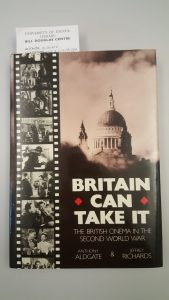For this week, we looked into the “Britain can take it” by Anthony Aldgate, published in 1986. Which explores the topic of British Cinema in the second World War. We believe this book was written to demonstrate how cinema played a vital role in sustaining the morale of the British people during the years of 1939-1945.
We believe this book was written to demonstrate how cinema played a vital role in sustaining the morale of the British people during the years of 1939-1945.
The book examines the eleven key films during this time period, specifically looking into the issues it dealt with during the war, an analysis including reviews and social and political concerns as well as looking into the Anglo American relations. Indeed, they explain how this resulted in the 1946 production ‘A Matter of Life and Death’, which is one of the movie that we had in our screenings. Most of these movies like ‘A Matter of Life and Death’ is stressing on the fact that love and peace will always win over the war, hate and fight. It explains how these movies try to allow the audience to escape from all the stress they would have had. Obviously, as a film historian we can not understand the emotion that the audience would have had while watching these movies, but still we can get an idea of how much relief these movies would have been for them.
Another technical change that we can witness in these movies are the time duration. This book mentions that before the war time, movies were more than 80 minutes in length on average. During the World War II, people had to go back to short films, which is similar to the movies that we had in the early 1900’s. This explains why movies like Night Mail and Listen to Britain are less than 30 minutes long.
This book doesn’t touch on anything outside of the eleven films, although precise, it prevents us from learning anything outside of these as there were over the main portion of years, 300 feature films (150 a year) and thousands of short films. The book doesn’t look into the historical aspects that built up to these productions but rather the impact and reaction it had on audiences.
Bordwell’s Basic Approaches to Film History:
Bordwell writes of the 5 ‘basic approaches’ needed in order to explain film history. These include Biographical history, industrial or economic history, aesthetic history, technological history and finally, social/cultural/political history. His theory being that there is not one general history but a large amount of subcategories that must all be payed attention to. In regards to our source, “Britain Can Take It” (1986) we can apply Bordwell’s thinking. The ‘Social/cultural/political history’ can be related to our chosen book, as the economic history is shown through the struggles of the economy and circulation of wealth due to the politics in WWII . Furthermore aesthetic history in regards to “Britain can take it” is mainly seen through the hardships of grief, pain and loss experienced through the war whilst contrasted. with the entertainment and developments of film at the time.

This is a very good post that features an excellent source in Britain Can Take It. You link your findings well with this week’s lecture and also take three of this week’s films into account.
Your observation about the limitations of focussing on only 11 films is well-made. It can, of course, be difficult for any writer to account for “everything” of course, but I agree completely that we must adjust our analysis of the text accordingly (i.e. this is a partial and not an exhaustive account of British cinema during the war).
Film duration is interesting. There were both short and feature-length films made of course: often the former were shown before the latter in order to provide the British public with vital information/inculcate them with propaganda. This in turn, affects the audience experience of course as we saw in this week’s lecture.
Good use of Bordwell to contextualise your findings!
Another technical change that we can witness in these movies are the time duration. This book mentions that before the war time, movies were more than 80 minutes in length on average. During the World War II, people had to go back to short films, which is similar to the movies that we had in the early 1900’s. This explains why movies like Night Mail and Listen to Britain are less than 30 minutes long.